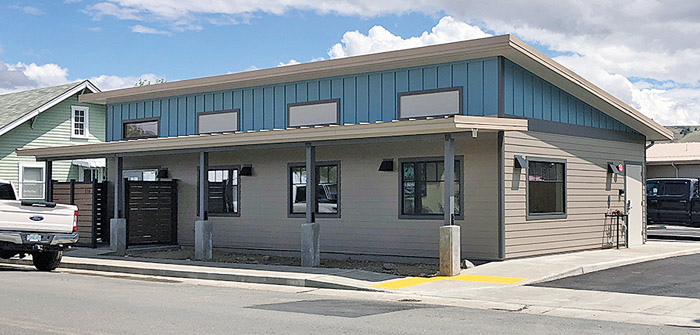(Construction update photo of Meredith House. The General Contractor is putting the finishing touches on the exterior and interior. Landscaping begins next | Photo Courtesy of Pinnacle Architecture)
There is a critical need in the community, and you have an idea but are not sure how funds are raised to make it a reality. The following four case studies from around Oregon showcase the different fundraising approaches for capital construction projects.
Canyon Edge Affordable Housing in Redmond
With so many rent-burdened residents in the region, the addition of Canyon Edge is critical to helping solve Central Oregon’s housing crisis. It is a unique project, spread across two sites just 300 feet apart amongst other multi-family and single-family homes. The project added 67 affordable homes to the community.
So how did it get funded? The project owner, Housing Works, applied for a funding opportunity through the Oregon Housing and Community Services (OHCS) state department. Millions of federal dollars are distributed to each state every year, and housing developers respond to a Notice of Funding Available (NOFA) to compete for the money. Learn more about this funding opportunity at oregon.gov/ohcs.
Meredith House Domestic Violence Shelter in John Day, Oregon
Heart of Grant County represents The Oregon Coalition Against Domestic & Sexual Violence in Grant County. They are creating a safe place for victims of domestic and sexual violence to find support. The new building provides space for organization operations and counseling services and has a small living space used as a temporary shelter for those in need.
So how did it get funded? The owner, Heart of Grant County, applied for a Community Development Block Grant. These federal funds are dispersed to each state to develop livable urban communities for persons of low and moderate incomes. Learn more about this funding opportunity at orinfrastructure.org.
Community Hall Renovation and Expansion in Dayville, Oregon
Dayville is a small Eastern Oregon town rooted in history. The original Hall was built by community shareholders in 1920 and is referred to as the city’s heart. The aging building needed many upgrades to continue to be safe and a community resource. The project is currently under construction and includes a complete interior and exterior renovation preserving the historical aspects of the Hall.
So how did it get funded? Dayville is a small community and didn’t have the in-house resources to research and apply for funding opportunities. They hired an independent grant writer to help them apply for a Community Development Block Grant. Nonprofit consultants offer various services, from strategic planning and market research to capital campaign design and grant writing. A few who have successfully helped our clients are listed at pinnaclearchitecture.com/resources.
Elgin Family Health Clinic in Elgin, Oregon
The Elgin Family Health Clinic functioned from a 1,900-square-foot, outdated and crowded space for more than 50 years. They were in desperate need of a new facility to support the health of their community. The Elgin Health District board members and the community pulled together to help raise funds. Now they have a new, efficient health center combining medical, dental, physical therapy, behavioral health and pharmacy under one roof to serve the community of Elgin.
So how did it get funded? This project took a village to fund and a very dedicated board of directors. They asked state officials, applied to multiple private grants and had numerous community fundraisers. In the end, funds came from Grande Ronde Hospital, Oregon State Capital Construction Lottery Funding, foundation grants and private donations. Pinnacle maintains a list of capital construction grants that helped the Elgin Health District connect with private funders. You can request a copy at pinnaclearchitecture.com/contact.
There is no one approach to funding vital community projects. Before pursuing funding opportunities, it’s essential to have a good plan and input/consensus from your community. Pinnacle helps our nonprofit client in the early planning phase by doing an architectural feasibility study. This study helps determine what size building they need for the services they want to offer and if a particular location is feasible. Next, we create 3D renderings to visualize the project. Along with a well-constructed business plan, these items help tell the story of the project and increase funding success.
Jessica Biel is a director at Pinnacle Architecture. With a 20-year background in marketing, she provides a resource to her firm’s clients. Biel maintains a capital campaign grant list, creates marketing materials to highlight projects for funding packets and community outreach and supports her client’s grant needs. Biel can be reached at Jessica@parch.biz or 541-388-9897.




